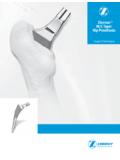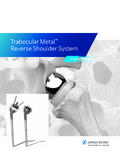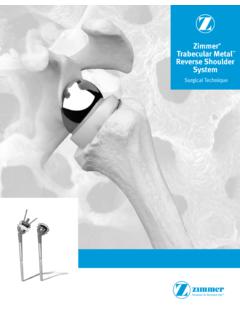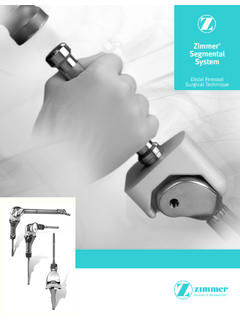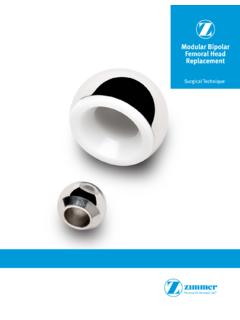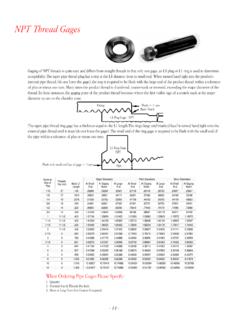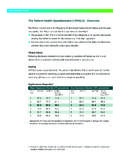Transcription of VerSys Fiber Metal Taper Hip Prosthesis - Joint Replacement
1 VerSys Fiber Metal Taper Hip ProsthesisSurgical Technique1 VerSys Fiber Metal Taper Hip Prosthesis Surgical TechniqueVerSys Fiber Metal Taper Hip Prosthesis Surgical TechniqueTable of ContentsPreoperative Planning 2 Determination of Leg Length 2 Determination of Abductor Muscle Tension and Femoral Offset 3 Component Size Selection/ Templating 3 Surgical Technique 5 Incision 5 Exposure of the Hip Joint 5 Determination of Leg Length 5 Osteotomy of the Femoral Neck 5 Preparation of the Femur 7 Intramedullary Reaming (Optional) 8 Attachment of the Rasp Alignment Tip (Optional) 10 Femoral Rasping 10 Trial Reduction 11 Insertion of the Femoral Component 12 Attachment of the Femoral Head 12 Wound Closure 12 Postoperative Management 12 VerSys Fiber Metal Taper Specifications 13 Fiber Metal Taper Standard Offset 13 Fiber Metal Taper Extended Offset 13 VerSys Fiber Metal Taper Hip Prosthesis Surgical Technique2 Preoperative PlanningEffective preoperative planning allows the surgeon to predict the impact of different interventions in order to perform the Joint restoration in the most accurate and safest manner.
2 Optimal femoral stem fit, the level of the femoral neck cut, the prosthetic neck length, and the femoral component offset can be evaluated through preoperative radiographic analysis. Preoperative planning also allows the surgeon to have the appropriate implants available at objectives of preoperative planning include:1. determination of leg length, 2. establishment of appropriate abductor muscle tension and femoral offset, and3. determination of the anticipated component overall objective of preoperative planning is to enable the surgeon to gather anatomic parameters which will allow accurate intraoperative placement of the femoral of Leg LengthDetermining the preoperative leg length is essential for restoration of the appropriate leg length during surgery.
3 For most patients, leg lengths are not equal. If leg lengths are equal in both the recumbent and standing positions, the leg length determination is simplified. If there are concerns regarding other lower extremity abnormalities, such as equinus of the foot or significant flexion or varus/valgus deformities of the knee, perform further radiographic evaluation to aid in the determination of preoperative leg length status. An A/P pelvic radiograph often gives enough documentation of leg length inequality to proceed with surgery. If more information is needed, a scanogram or CT evaluation of leg length may be helpful. From the clinical and radiographic information on leg lengths, determine the appropriate correction, if any, to be achieved during surgery.
4 If the limb is to be significantly shortened, osteotomy and advancement of the greater trochanter may be necessary. If the limb is shortened without osteotomy and advancement of the greater trochanter, the abductors will be lax postoperatively, and the risk of dislocation will be high. Also, gait will be compromised by the laxity of the abductors. If leg length is to be maintained or increased, it is usually possible to perform the operation successfully without osteotomy of the greater trochanter. However, if there is some major anatomic abnormality, osteotomy of the greater trochanter may be Fiber Metal Taper Hip Prosthesis Surgical TechniqueDetermination of Abductor Muscle Tension and Femoral OffsetOnce the requirements for establishing the desired postoperative leg length have been decided, the next step is to consider the requirement for abductor muscle tension.
5 When the patient has a very large offset between the center of rotation of the femoral head and the line that bisects the medullary canal, the insertion of a femoral component with a lesser offset will, in effect, medialize the femoral shaft. To the extent that this occurs, laxity in the abductors will Fiber Metal Taper stems are offered in two offsets (standard and extended) in a 135-degree neck angle. This versatility in offset and length enables the surgeon to reproduce almost any offset rare, it may not be possible to restore offset in patients with an unusually large preoperative offset or with a severe varus deformity. In such cases, the tension in the abductors can be increased by lengthening the limb, a method that is especially useful when the involved hip is short.
6 If this option is not advisable and if the disparity is great between the preoperative offset and the offset achieved at surgery by using the longest head-neck implant possible, some surgeons may choose to osteotomize and advance the greater trochanter to eliminate the slack in the abductor muscles. Technical variations in the placement of the acetabular components can also reduce the differences in Size Selection/ TemplatingPreoperative planning for insertion of a cementless femoral component requires at least two views of the involved femur; an anterior/posterior (A/P) view of the pelvis centered at the pubic symphysis, and a frog leg lateral view on an 11x17-inch cassette. Both views should show at least 8 inches of the proximal femur. In addition, it may be helpful to obtain an A/P view of the involved side with the femur internally rotated.
7 This compensates for naturally occurring femoral anteversion and provides a more accurate representation of the true medial to lateral dimension of the templating, magnification of the femur will vary depending on the distance from the x-ray source to the film, and the distance from the patient to the film. The VerSys Hip System templates (Fig. 1) use standard 20 percent magnification, which is near the average magnification on most clinical 1 Large patients and obese patients may have magnification greater than 20 percent because their osseous structures are farther away from the surface of the film. Similarly, smaller patients may have magnification less than 20 percent. To better determine the magnification of any x-ray film, use a standardized marker at the level of the femur.
8 (Templates of 15 and 10 percent magnification can be obtained by special order.)Preoperative planning is important in choosing the optimal acetabular component, and in providing an estimation of the range of acetabular components that might ultimately be initial templating begins with the A/P roentgenogram. Superimpose the acetabular templates sequentially on the pelvic x-ray with the acetabular component in approximately 40 degrees of abduction. Range of motion and hip stability are optimized when the socket is placed in approximately 35 to 45 degrees of abduction. Assess several sizes to estimate which acetabular component will provide the best fit for maximum coverage. In most cases, select the largest component possible, being certain that the outside diameter isn't too large to seat completely in the acetabulum.
9 (Refer to the various Zimmer Acetabular System surgical techniques for specific details on acetabular reconstruction.) VerSys Fiber Metal Taper Hip Prosthesis Surgical Technique4 Consider the position and thickness of the acetabular component in estimating the optimum femoral neck length to be used. (To simplify this, the acetabular templates are on a separate acetate sheet from the femoral templates.) Mark the acetabular size and position, and the center of the head on the x-rays. This allows any femoral component to be matched with the desired acetabular component by placing the femoral template over the acetabular template. This will provide the best estimation of femoral component size and head-neck length necessary to achieve the correct leg VerSys Hip System includes several head diameters.
10 In most patients with an average-sized acetabulum, consider a femoral head with an intermediate diameter, such as 28mm or 32mm. The intermediate femoral heads allow the use of an acetabular component with an outside diameter small enough to seat completely in the bone while also allowing for a polyethylene liner of sufficient special circumstances, such as the treatment of small patients and patients with congenital hip dysplasia and small acetabular volume, it is preferable to use a 22mm diameter head to allow for adequate polyethylene specific objectives in templating the femoral component include:1) determining the anticipated size of the implant to be inserted, and2) determining the height of the implant in the femur and the location of the femoral neck osteotomy.
